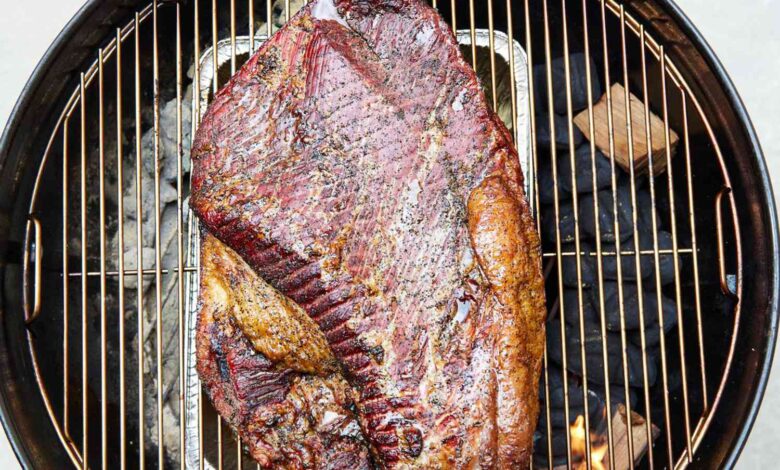Texas-Style Brisket Doesn’t Have to Be Complicated—Here’s Proof

Why It Works
- This recipe is written to work using either a smoker or a charcoal grill, so you can make it no matter which setup you have.
- The two-stage cooking method (smoking, then steaming) builds deep smoke flavor while ensuring juicy, tender meat.
- Using a water pan stabilizes the temperature and prevents flare-ups, promoting even cooking and bark development.
- Wrapping the brisket tightly in foil to finish cooking steams the meat, which tenderizes it and reduces the cooking time.
Texas-style smoked brisket is more than just barbecue. It’s a cultural landmark, a culinary ritual, and arguably the crown jewel of American low-and-slow cooking. It is also a deceptively simple dish—just beef, salt, pepper, smoke, and time. And yet, achieving great brisket at home is often framed as a high-stakes undertaking, a trial by fire (and charcoal) that leaves many backyard pitmasters either too intimidated to start or discouraged to try again.
I’m here to say: Brisket is absolutely worth it—and it’s far more doable than you might think.
This recipe is the result of years of practice, dozens of tests, a few smoky disasters, and countless delicious slices of beef. Whether you’ve got a dedicated smoker or a kettle charcoal grill, I’ll show you how to pull off deeply flavorful, tender Texas-style brisket right in your backyard, without fancy gear or competition-level stress.
But before we discuss technique, let’s consider the origins of this dish and why it’s so fiercely loved.
A Brief History of Brisket in Texas Barbecue
Brisket wasn’t always barbecue royalty in the US. For most of its history, it was just a tough, cheap cut of meat that butchers struggled to sell. As late as the 1950s, Texas barbecue joints were more likely to serve pork, mutton, or beef shoulder clod than brisket. But in Central Texas—home to a wave of 19th-century Czech and German immigrants who brought with them meat-smoking traditions and a deep respect for beef—brisket found its home.
Texan food writer Robb Walsh writes in Legends of Texas Barbecue that the first documented appearance of smoked brisket in a Texas barbecue context did not occur until 1910. The cut gained ground slowly, but by the 1960s and ’70s, places like Kreuz Market in Lockhart and Louie Mueller Barbecue in Taylor had turned it into their signature offering. These butchers-turned-barbecue-pros honed the method of seasoning brisket to the bare essentials—just salt and pepper—and cooking it low and slow over post oak wood until it was tender enough to cut with the side of a fork.
Fast-forward to today, and brisket has become a symbol of Texas barbecue at its purist: no sauce, no gimmicks, just smoke, meat, and patience.
Serious Eats / Vy Tran
What Makes Brisket So Tricky?
Brisket comes from the cow’s chest—a muscle that works hard and is loaded with connective tissue and intramuscular fat. It’s also oddly shaped, with one end (the flat) that’s lean and relatively uniform in thickness and the other (the point) that’s fattier, irregular, and thicker. This dual nature is part of the challenge: Getting both ends perfectly cooked simultaneously requires finesse, timing, and a little bit of experience.
If you cook it too quickly, you’ll end up with rubbery, dry meat. If you cook it too long without moisture, the outer bark will turn bitter and dry. But when it’s right—smoky, tender, juicy, and sliced just thick enough to show off the grain—it’s magic.
The Pit: Smoker or Grill?
Let’s be clear—you don’t need a $2,000 offset smoker to make excellent brisket. Sure, it’s nice to have gear that maintains a rock-steady 250°F with a whisper of smoke curling out the stack. But for most home cooks, a basic smoker or kettle grill and a little patience will do the job admirably.
If you have a smoker, great—you’re already ahead of the game. Set up the smoker based on the manufacturer’s recommendations. There are numerous styles of smokers that vary in shape (vertical, horizontal, or cabinet), fuel source (electric or charcoal), and size, so it’s impossible to provide detailed instructions for setting up your specific smoker. You’ll have success as long as you properly set up and maintain the smoker’s temperature between 225°F and 275°F (105 to 135℃) throughout the lengthy (six- to 10-hour) cooking process. Just don’t forget to add wood to the smoker every one to two hours to maintain a consistent smoke level during the brisket’s first cooking stage.
At this smoking stage, you are not cooking the brisket until it is tender. You are smoking the brisket low and slow to begin to soften its network of tough connective tissue while building rich smoky flavor. Once the brisket reaches 170℉, it’s time to pull the meat from the smoker, wrap it in foil, and then return it to the smoker to steam it to finish (we’ll get into those details below).
If you’re working with a charcoal grill, the game changes a bit. Enter the “charcoal snake.”
Meet the Snake: An Easy, Reliable Method of Smoking on a Grill
No smoker? No problem! You can still make impressive low-and-slow brisket on a kettle charcoal grill. Better yet, with the proper setup, you can do so without needing to babysit the grill every hour to gauge the smoking temperature or to add more coals or wood.
The charcoal snake (sometimes called the C-ring or fuse method) is a clever setup that lets you maintain a low, steady heat for hours on a standard 22-inch kettle grill without constant fiddling.
Serious Eats / Vy Tran
In my opinion, the snake is the easiest and best way to smoke large cuts of meat on a charcoal grill. It’s as close as you will get to a “set it and forget it” outdoor slow-cooking project.
The snake has long been a popular method among barbecue enthusiasts, but I was first introduced to it by Morgan Bolling, barbecue expert and executive editor of the magazine Cook’s Country. After learning about the snake from Bolling, I went on to use the technique repeatedly while developing recipes for cookbooks at America’s Test Kitchen, the parent company of Cook’s Country.
Here’s how it works: Line the edge of your grill with a double row of slightly overlapping charcoal briquettes in a semicircle, then stack another row on top. Nestle wood chunks at intervals along the snake. Light one end, and as the briquettes slowly ignite down the line, they light the wood, producing smoke and heat for six hours or longer.
Serious Eats / Vy Tran
The goal with this setup is to achieve a consistent temperature and a long burn without needing to add more coals or wood every hour. There is only one point in the lengthy cooking time when additional coals need to be added to the grill—when the meat reaches 180°F and it is removed from the grill to be wrapped in aluminum foil so it can finish cooking with steam. (I’ll describe this steaming process a bit further down.)
Admittedly, when this snake setup is used, it runs a bit hotter than is generally considered ideal for smoking brisket. As the charcoal snake burns, the temperature fluctuates from 225℉ all the way up to 325℉, a good 50℉ hotter than the 275℉ cap most folks try to stay under when smoking this particular cut of meat. Since it reaches a higher temperature for extended periods of time while cooking, the final cooking time is overall shorter than you’d use with a smoker running in the 225 to 275℉ range.
Before any hardcore smoking aficionados scoff at this method due to that slightly elevated temperature, I assure you that I have cooked and tested many briskets with the charcoal snake setup and compared them against versions cooked on a smoker at the standard lower cooking temperature. I can confirm that the final texture and flavor of the meat are comparable. The differences are minimal, and the result is still very much worthwhile at the slightly higher temperature.
Still, there’s no harm in tempering the heat swings of the snake method—and one simple way to do that is by placing a large disposable aluminum tray filled with water in the center of the grill, directly beneath where the brisket will sit. The water acts as a thermal buffer, absorbing excess heat and helping to stabilize the grill’s temperature, much like a baking stone in a home oven. It also catches rendered fat during cooking, helping to prevent flare-ups that could spike the grill’s temperature and throw off the low-and-slow rhythm.
If the charcoal snake setup doesn’t sound like your style, you can opt for Joshua Bousel’s kettle grill method instead. It’s quicker to set up and doesn’t require stacking or counting coals, but it does demand more active monitoring throughout the cooking time. If you go this route, stick with the smoker timing in the recipe, as the grill temperatures will more closely mirror that method.
Why We Steam Brisket After Smoking
Once your brisket reaches about 170°F, the collagen has begun to break down, and the meat has soaked up enough smoky flavor. It’s now time to finish it by steaming. For this steaming stage, the brisket is removed from the smoker or grill, then wrapped tightly with multiple layers of aluminum foil (the “crutch”), before being placed back on the smoker or grill to finish cooking. Any liquid coming off the meat is trapped in the foil wrapping, creating steam, which allows you to power through what’s known as “the stall,” when the temperatures can no longer rise due to evaporative cooling.
At this point if you’re using a charcoal grill, you’ll need to add about a half chimney’s worth of unlit coals to the still-unlit end of the snake to extend it. This guarantees enough heat to finish cooking the brisket. If you’re using a smoker, you’ll continue to monitor the heat source and maintain its temperature. In both cases, there’s no need to add any more wood—you just need to keep the heat going.
You might ask, “Why not just smoke it all the way through until it’s fully cooked? Why switch up the cooking method partway through?” The short answer is that this would take too long, resulting in the meat becoming overly smoky in flavor. The smoke should act as a seasoning for the meat, not overpower it.
This second phase isn’t about flavor—it’s about tenderness. As mentioned above, it pushes you past the stall, a frustrating phase when the internal temperature plateaus (typically between 160°F and 180°F) due to evaporative cooling. A common misconception is that the stall has something to do with the vast amount of fat and collagen in larger tougher cuts of meat, but this is not the case. It has nothing to do with fat or collagen. The stall is caused by moisture evaporating from the surface at this stage of cooking and starting to cool the meat. If you steam the meat at this point, it eliminates the evaporative cooling effect, causing the temperature to rise more quickly and reach a temperature of 195℉ or higher, allowing the meat to become fully tender. Wrapping the brisket also creates a moist environment that lets the meat gently steam to doneness without drying out. After steaming, you’re looking for a final internal temperature of about 200℉ for the brisket’s collagen to fully break down and be pleasantly tender.
Is this technique “cheating”? Some purists might say so. But for the home cook, it’s a smart, reliable way to get perfectly tender results without babysitting a fire for more than 14 hours. And if it’s good enough for Franklin Barbecue in Austin, where they wrap their briskets in butcher paper partway through, it’s good enough for us. In his book, Franklin Barbecue: A Meat-Smoking Manifesto, Aaron Franklin, a modern authority on brisket, explains that wrapping helps power through the stall and retain moisture. He says, “Wrapping is not cheating—just make sure you do it at the right time.” What matters is the result: a tender, juicy brisket with deep, balanced smoke flavor and a bark that holds its own.
The Resting Time Is Critical
One of the biggest mistakes you can make with brisket is slicing too soon after it comes out of the smoker or grill. Like any large roast, brisket needs to rest. After cooking, let it sit wrapped at room temperature for at least two hours—or better yet, transfer it to an insulated cooler and let it rest for three. This resting time allows the juices to redistribute and the collagen to finish breaking down, making for juicy and rich slices instead of dry and crumbly ones.
When you’re ready to slice, use a long, sharp slicing knife and cut across the grain into slices that are approximately a quarter to half an inch thick. If the grain direction changes at the point (it does!), rotate as needed.
The Wood and Rub (or Lack Thereof)
Traditional Central Texas barbecue uses mild, clean, and steady-burning post oak wood. Suppose you can find it—great. But other hardwoods, such as hickory, pecan, or fruit wood blends, will still produce stellar results. Avoid resinous woods like pine or fir, which burn dirty and taste harsh.
As for seasoning, the classic rub is as minimal as it gets: coarse kosher salt and freshly cracked black pepper. That’s it. No sugar, no garlic, no paprika. This lets the flavor of the beef and smoke take center stage. If you’re tempted to reach for extra spices, try the traditional way first—it’s surprisingly complete.
Smoking a brisket at home may seem intimidating, but it’s one of the most rewarding things you can cook. It teaches patience, demands respect, and yields tender, flavorful slices of meat that are deeply satisfying to serve and eat.
To quote the late, great Anthony Bourdain, “Barbecue may not be the road to world peace, but it’s a start.” If that road starts in your backyard with a brisket and an ice cold drink, you’re off to a damn good beginning.





